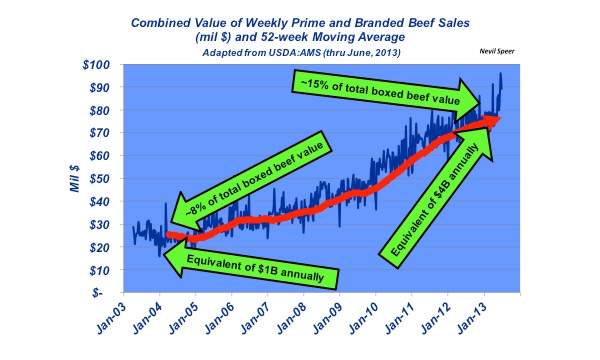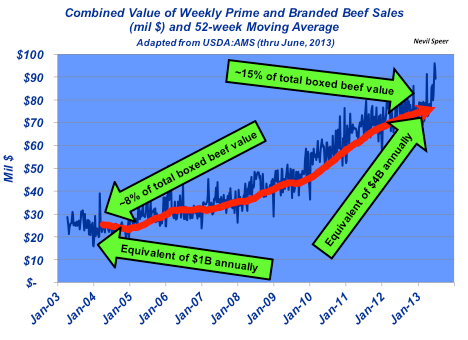Industry At A Glance: High-Quality Beef’s Economic Contribution
High-quality beef accounts for an-ever larger portion of the beef industry’s total revenue.
July 9, 2013

The 2013 Beef Improvement Federation meetings featured an industry-wide panel discussion regarding breeding systems and their relationship to customer satisfaction.
The importance of hitting the consumer target can’t be understated. The effect of establishing positive demand spells prosperity: more customers buying more beef at higher prices. Conversely, failure to consistently generate favorable eating experiences negatively influences demand. That ultimately results in the need for lower throughput, weaker markets and less available revenue for all stakeholders in the beef business.
That reality is best demonstrated by wholesale beef sales trends over the past 10 years or so. The illustration highlights the change in combined value (function of both price and volume) of Prime and branded beef sales. Total value 10 years ago was equal to approximately $20 million/week (or the equivalent of about $1 billion annually) and represented approximately 8% of the wholesale market. Fast-forward to 2013 and that value has increased four-fold to $80 million/week (or $4 billion annually) and now accounts for 15% of the beef wholesale market (not to mention, establishing a new weekly record of $96 million in mid-June).

In other words, high-quality beef is accounting for an ever-larger portion of the beef industry’s total revenue. That has a real impact on the cattle market. The annual difference in value over time represents $3 billion. For simplicity’s sake, assuming a 30-million-head calf crop, that’s equivalent to an additional $100/head or an additional $20/cwt. for every 500-lb. calf born in the U.S. that wasn’t available 10 years ago (whether they ultimately produce a high-quality carcass or not – a rising tide).
All that discussion underscores the importance of each stakeholder in the value chain, from the first supplier to the end consumer, as part of a large network. How will that influence the shape of the industry in the future? Where do you see future breeding systems and management schemes headed to meet these consumer targets? How do you perceive the importance of the customer within our business as it translates back into the production sectors?
Leave your thoughts below.
About the Author(s)
You May Also Like




.png?width=300&auto=webp&quality=80&disable=upscale)
